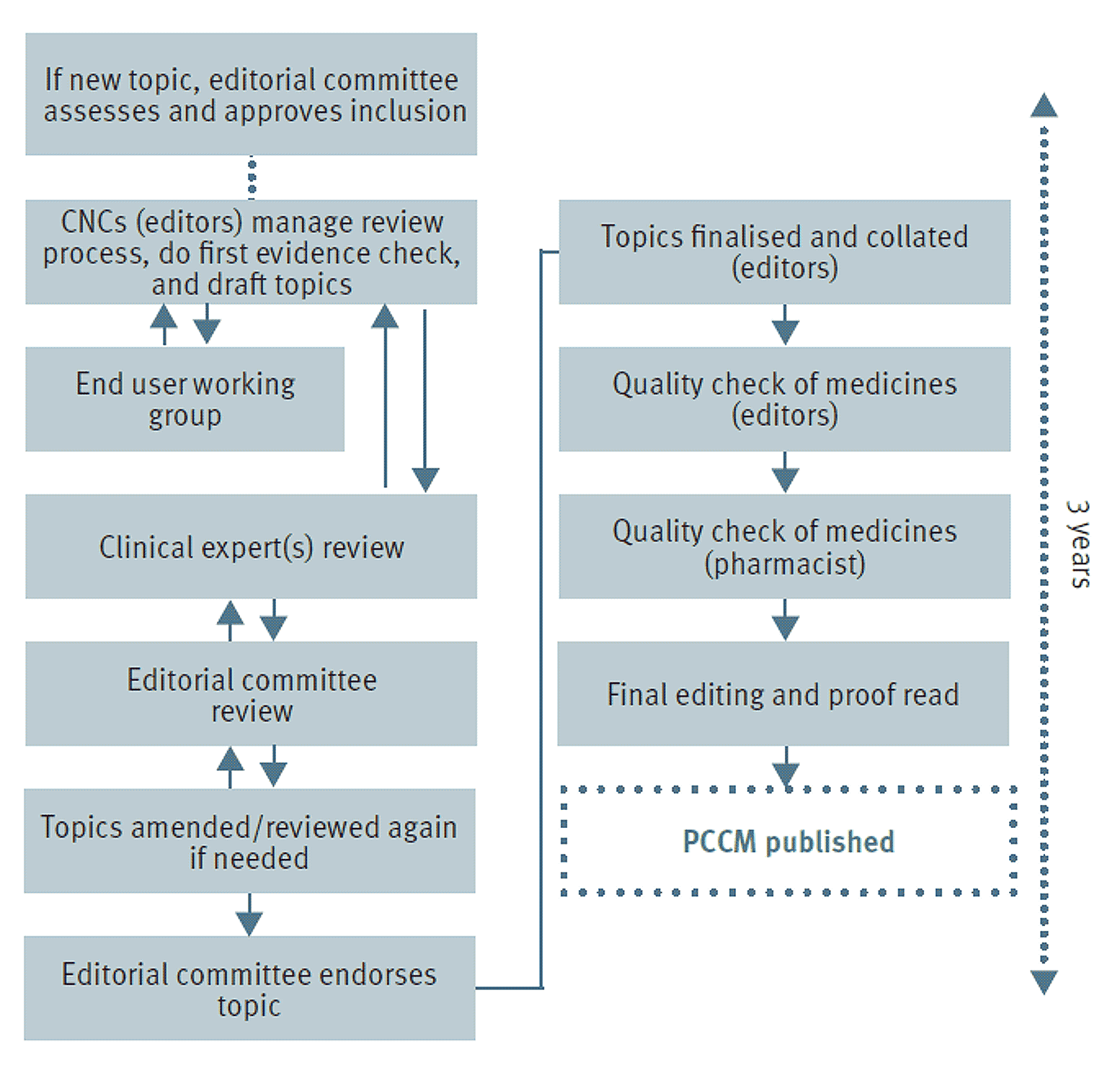About the PCCM
Review process
The Primary Clinical Care Manual is published every 3 years.
The Review process is illustrated in the diagram below.

Editors (clinical nurse consultants)
- Clinicians experienced in rural, remote, and isolated practice area nursing and midwifery
- Manage review process
- Shape tone, clarity, and brevity of topics to ensure it integrates with other content in the PCCM, and is relevant to the rural, remote, and isolated practice context
- Research clinical evidence and prepare initial draft of topics
End user working group
- A group of rural, remote, and isolated practice area clinicians who currently use the PCCM in their day-to-day practice
- Provide advice from a user’s perspective, for example, on general content, ease of use and format
Clinical experts
- Clinicians with expertise in the topic
- Review drafted topics, assess evidence, collaborate with editors until topic ready for presentation to the editorial committee
Editorial committee
- Represents diversity and experience across various rural, remote, and isolated practice areas
- Multidisciplinary clinical group of approximately 15 people. This includes medical officers, RIPRNs from Queensland and Victoria, nurse practitioner(s), midwives, Aboriginal and Torres Strait Islander Health Practitioner(s), pharmacist(s), clinical leads from Queensland Ambulance Service, the Australian Defence Force, Remote Primary Health Care Manuals (ie CARPA), and the Cunningham Centre RIPRN course
- Chaired by a senior medical officer. Chair alternates between Queensland Health and Royal Flying Doctor Service (Queensland Section) each edition
- A conflict-of-interest declaration is sought from each committee member at the commencement of each meeting
Feedback and updates
- Feedback regularly received from users, and assists us to improve content
- All feedback is assessed and managed via an editorial sub-committee.
- If updates are required to the controlled (online) version of the PCCM, they will be listed here
- Feedback is encouraged and very welcome
Structure and Format
The PCCM is organised in sections, then grouped into subsections according to similar topics or body system effected.
Sections
- Patient assessment and transport
- Pain, nausea and vomiting
- Emergency
- General
- Mental health and alcohol withdrawal
- Obstetrics and neonatal
- Sexual and reproductive health
- Paediatrics
- Immunisations
- Appendices
Format of each topic
- Recommend and background
- Related topics
- May present with
- Immediate management
- Clinical assessment
- Management
- Follow up
- Referral/consultation
Drug (medicine) boxes
Drug boxes include the following information:
- Generic name of medicine and Schedule
- Extended authority (specific to Queensland)
- Details about authority i.e. to consult medical officer or nurse practitioner, or proceed to initiate the medicine
- Form, strength, route, dose, and duration of the medicine
- Consumer medicine information (CMI) – not comprehensive, only includes selected points
- Contraindication
- Management of associated emergency
Health Management Protocol (HMP) and Clinical Care Guidelines
Some topics are notated with HMP. This indicates that there is reference to a medicine in the topic, which a clinician with an extended practice authority (in Queensland) can use.
Topics without HMP are simply referred to as clinical care guidelines.
Where it's used
The PCCM is used across Australia. It is the principal clinical reference in rural, remote, and isolated practice areas throughout Queensland, Victoria, and the Australian Defence Force.
References
The PCCM reference booklet is available here
Disclaimer
The Primary Clinical Care Manual 11th edition 2022 is distributed by Queensland Health and the Royal Flying Doctor Service (Queensland Section) as an information source only and does not replace clinical judgment. The information is provided solely on the basis that readers will be responsible for making their own assessment of the matters presented herein and readers are advised to verify all relevant representations, statements and information. The information does not constitute clinical advice and should not be relied upon as such.
In no event shall Queensland Health or the Royal Flying Doctor Service of Australia (Queensland Section) be liable (including liability for negligence) for any claim, action, proceeding, demand, liability, costs, damages, expenses or loss (including without limitation, direct, indirect, punitive, special or consequential) whatsoever brought against or made upon or incurred by Queensland Health or the Royal Flying Doctor Service of Australia (Queensland Section) arising out of or in connection with a person's use of or reliance on or inability to use the information or instructions provided in this publication, or incorporated into this publication by reference